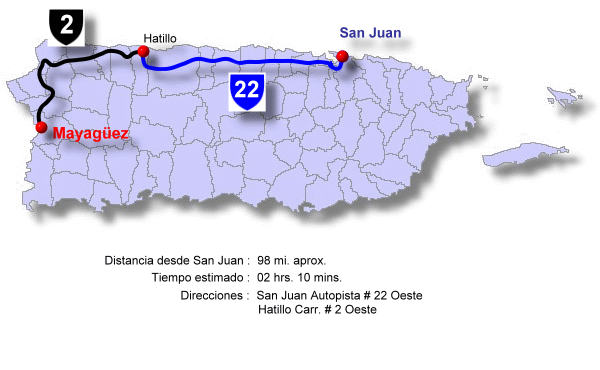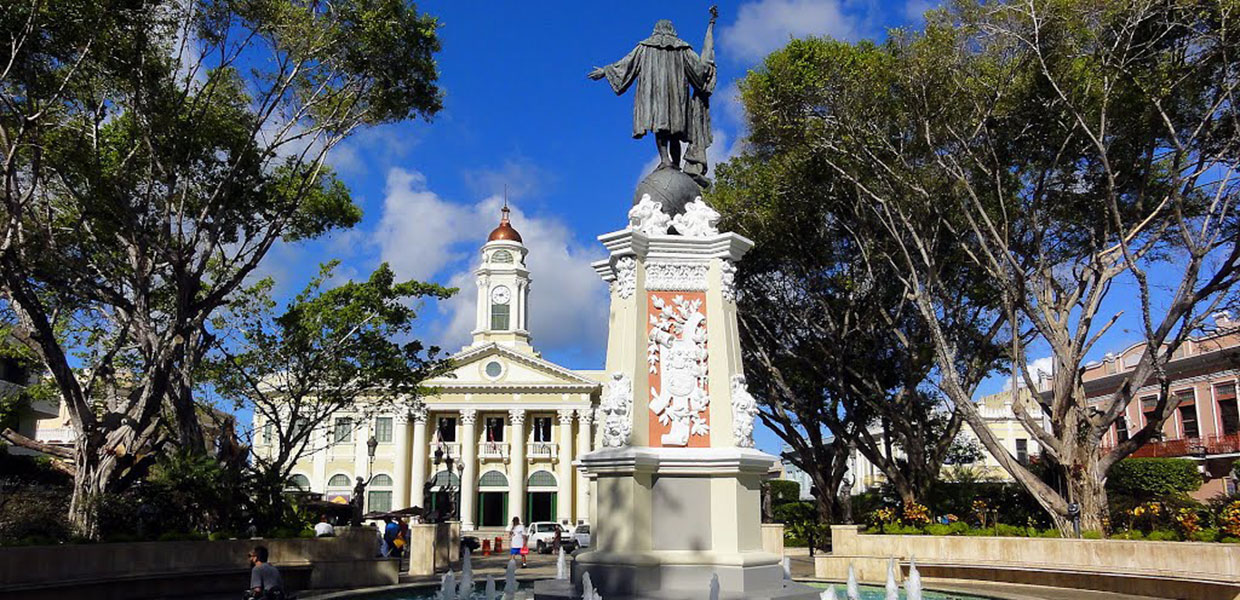
Mayagüez, Puerto Rico
Sultan of the West
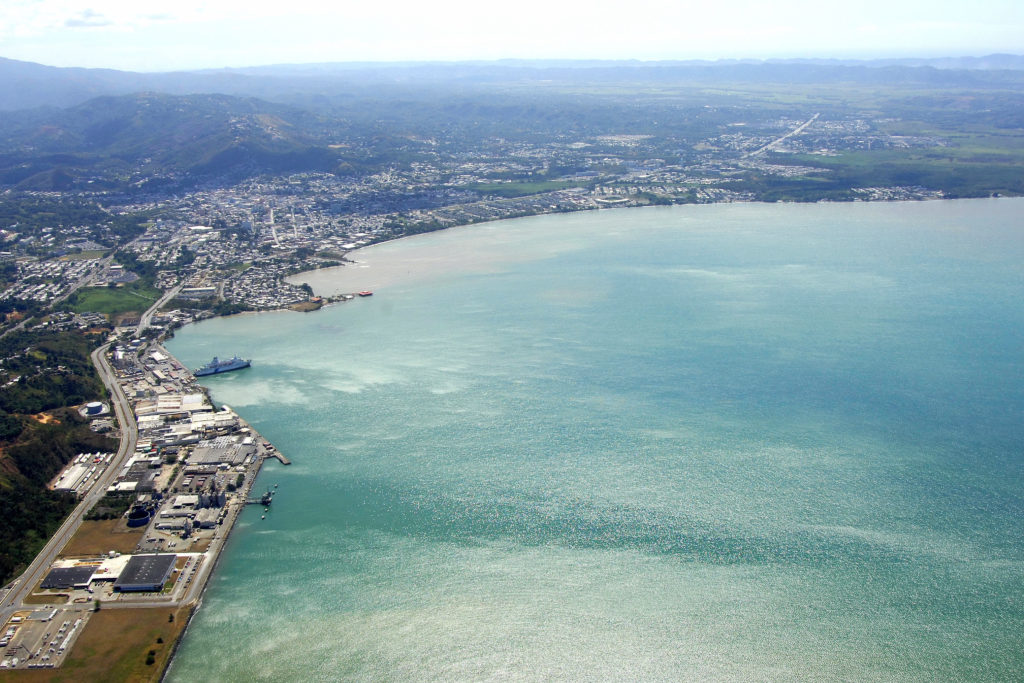
Mayagüez (mah-yah-GWES) is known as “the Sultaness of the West,” because, according to legend, there was an extraordinarily beautiful woman of Arab features with whom everyone fell in love. It has also been called the “the city of pure waters”, “the birthplace of Eugenio María de Hostos,” the “jelly roll city,” “the city of the Indios (a baseball team), and “the mango town”. The patron of the city is Our Lady of Candlemas.
This municipality is located on the west coast of Puerto Rico. It is bordered on the north by Añasco and Las Marías; Cabo Rojo, Hormigueros and San Germán on the south; Maricao and Las Marías on the east and the Mona Channel on the west. The city is located in the western coastal valley region. The land is largely flat and fertile, thanks to the abundant rain, which falls mainly between May and November.
Mayagüez is home to the Mayagüez Campus of the University of Puerto Rico (formerly the College of Agriculture and Mechanical Arts) and the Dr. Juan A. Rivero Zoo.
The city is part of the development plan known as “Porta del Sol,” which is directed at showcasing the natural resources, the gastronomy, the arts, and general culture of the western region.
Economic development has included registered trademarks that have been hallmarks for the city: Franco jelly roll, Cedó flan, and Fido sangría. The port area is undergoing constant development.
Foundation:
Mayagüez was founded in 1760 by don Faustino Martínez de Matos, Juan de Silva and Juan de Aponte. In 1772 it had 50 houses, 419 families and 1,800 inhabitants. Its development was slow and its economy depended almost exclusively on agriculture. The town simultaneously developed in two areas: the town in the “high lands” and at the seaside. The port was an important point of export to all of the adjacent towns among them San Germán, Cabo Rojo and Añasco.
In 1836 the title of Villa was granted to the town of Mayagüez, which gave it the right to have a town hall and a four tower crown in its coat of arms. The name comes from the river on which the town was developed, the Yagüez. This town previously was well known as Mayagüex, which in the Taíno language means “site of water”, according to Juan de Castellanos.
In 1841 one of the first catastrophes took place; it was called the Great Fire of 1841. Many other catastrophes would affect the city. This voracious fire destroyed a great part of Villa de Mayagüez; the population had 700 houses and less than 10% survived.
During the middle of 19th century certain institutional buildings of importance existed, among them Customs, the Consistorial House, the Infantry Headquarters, the Public Jail and the Military Hospital.
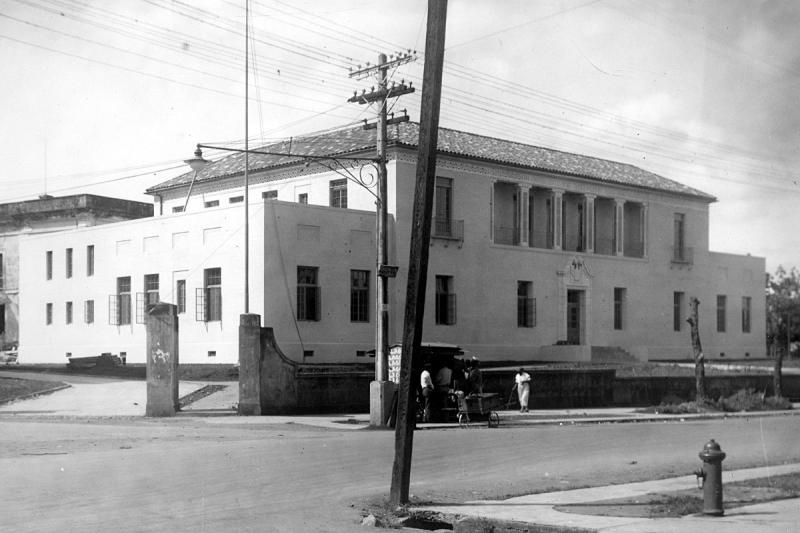
During 1870, advances in the technology of communications allowed telegraph service between Mayagüez and San Juan. In this same year, don José de González y Echevarría presented a proposal for the Urban Railroad of the Mayagüez Villa. It began service in 1875 and consisted of a car drawn by horses. It connected the Town with the Beach through Méndez Vigo Street. The rails of this system were of the “Picket” type, solid iron forged cylinders spaced uniformly without the use of crossbeams.
The system had multiple problems, among them the propulsion method used and the steep hill of Méndez Vigo Street, which made the trip difficult and very slow. In 1886 it operated for the last time and its permission to operate was cancelled the following year. In 1893 a proposal for a second system of street cars was made.
In 1895 the Sociedad Anónima Tranvía de Mayagüez began to offer service. The motive force continued to be provided by horses, but thanks to certain improvements in the infrastructure, the quality of the service improved greatly. The route connecting the town and the beach continued through Méndez Vigo Street, but to avoid the steep hill at Suau Park, it was diverted through what is now known as McKinley Street. Several modifications to the main line were made, among them one route through the Market Plaza. In 1897 the Guanajibo street car was put in service. The route ran from Commerce Street throughout the coast to the Guanajibo ward.
The first decade of 20th century was one of adaptation. In the 1912 the Sociedad Anónima Tranvía de Mayagüez stopped its operations. During December 1913 the installation of a third street car system, the Mayagüez Tramway Company, for the city was approved by the Executive Council. This new system operated with electricity and the cars had a greater passenger capacity. The route was of the “point to point” type from the beach to the Balboa ward by way of Méndez Vigo Street.
On October 11 of 1918, during the month of October, the tranquility of the country was interrupted by the sudden and most devastating earthquake that Puerto Rico has experienced in the 20th century. This earthquake had an approximate magnitude of 7.5 in the Richter scale and was accompanied by a tsunami that reached six meters in height. The damage was concentrated in the western region of the Island because of its vicinity to the epicenter.
The decade of the 1920’s was one of reconstruction and development. The arrival of the automobile, which provided fast and effective transportation service, eliminated the railroad system of Mayagüez. It ceased operations in 1926.
Location:
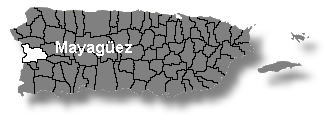 Mayagüez is located in the west coast. It is bordered by: Añasco and Las Marías on the north; by Red Cabo, Hormigueros and San Germán on the south; the Mona Passage on the west; and Las Marías and Maricao on the east.
Mayagüez is located in the west coast. It is bordered by: Añasco and Las Marías on the north; by Red Cabo, Hormigueros and San Germán on the south; the Mona Passage on the west; and Las Marías and Maricao on the east.
Area:
197.6 sq km / 76.0 sq mi
Population:
98,434 (censo 2000)
Population Density:
498.1 per sq km / 1,295.1 per sq mi
Gentilicio:
Mayagüezanos
People are known as:
La Sultana del Oeste (Sultan of the West)
La Ciudad de las Aguas Puras (City of Pure Waters)
El Pueblo del Mango (Mango City)
Wards: Mayaguez, Puerto Rico
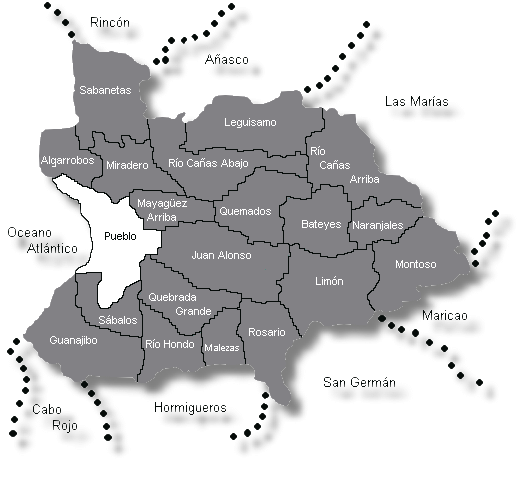
| Census 2000: Population by Wards – Mayagüez | Habitants |
| Algarrobos | 4,792 |
| Bateyes | 1,205 |
| Guanajibo | 7,165 |
| Isla de Mona e Islote Monito | 0 |
| Juan Alonso | 1,371 |
| Leguísamo | 2,080 |
| Limón | 1,622 |
| Malezas | 1,143 |
| Mayagüez Town | 32,043 |
| Mayagüez Arriba | 6,098 |
| Miradero | 5,510 |
| Montoso | 1,118 |
| Naranjales | 1,197 |
| Quebrada Grande | 6,333 |
| Quemado | 3,017 |
| Río Cañas Abajo | 2,318 |
| Río Cañas Arriba | 1,495 |
| Río Hondo | 3,865 |
| Rosario | 1,630 |
| Sábalos | 10,271 |
| Sabanetas | 4,161 |
| Total | 98,434 |
Source: Censo 2000
Patron:
Nuestra Señora de La Candelaria
Nuestra Señora de La Candelaria Parish
Apartado 220
Mayagüez, P.R. 00681
(787) 831-2444
Mass Scheduled
Daily: 6:30am, 7:15am & 5:30pm
Saturdays: 7:30am, 6:00pm & 7:30pm
Sundays: 6:30am, 8:00am, 9:30am, 11:00am, 5:00pm & 6:3Opm
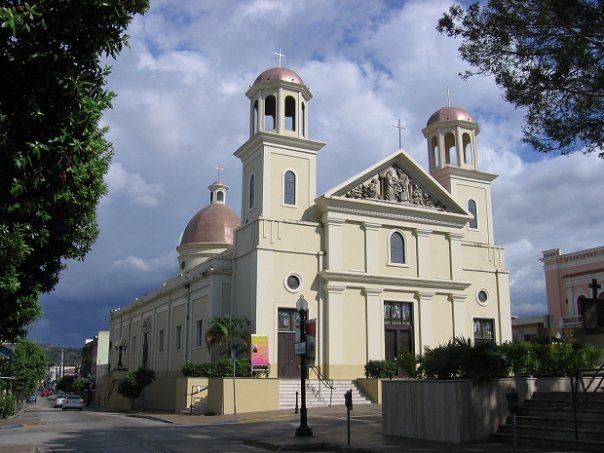
Topography:
This municipality belongs to the Western Coastal Valley region. Its territory is mainly level. The most elevated parts are in the northeast where the Urayoán Mountains rise.
Hydrography:
The Grande de Añasco, Guanajibo and Yagüez rivers form part of the hydrographic system.
Economy:
Manufacture (clothing), food, beer and services.
Average Salary:
$287.82 weekly (1998)
Flag:
 The wide cross represents Christianity brought to the New World by Cristopher Columbus, who signed his documents with the phrase and the sign of Christ Ferens, which means: “He who has Christ.” The blue and white waves in third to fourth quarter recalls the Shield granted to Columbus by the Catholic Kings. The waves represent the ocean and the Mona Passage in which he sailed to bring the gospel to these new lands. The blue and white waves symbolize the Yagüez River and recalls the nickname City of Pure Waters.
The wide cross represents Christianity brought to the New World by Cristopher Columbus, who signed his documents with the phrase and the sign of Christ Ferens, which means: “He who has Christ.” The blue and white waves in third to fourth quarter recalls the Shield granted to Columbus by the Catholic Kings. The waves represent the ocean and the Mona Passage in which he sailed to bring the gospel to these new lands. The blue and white waves symbolize the Yagüez River and recalls the nickname City of Pure Waters.
Coat Of Arms:
 The colombine shield recalls and commemorates the discovery of the Island of Borinquén, today Puerto Rico, by Cristóbal Columbus in his second trip to the New World in 1493.
The colombine shield recalls and commemorates the discovery of the Island of Borinquén, today Puerto Rico, by Cristóbal Columbus in his second trip to the New World in 1493.
The discoverer disembarked at the western coast of the island, where several rivers spill their waters in the Mona Passage, among them the Yagüez, from which the name of Mayagüez is derived.
Events:
- Three Kings Day Festival – January
- Patron Saint’s Festival – January/February
- Romance on the Boulevard – February
- Bomba and plena festival – February/March
- Mothers’ day concert – May
- Fathers’ day concert – June
- Mayagüez Carnival – May
- Danza Festival – May
- Celebration of the founding of Mayagüez – September
- Crafts fair – November
- Christmas festivities – December
- Anniversary of the Puerto Rican flag – December
- Band concert at the Patriots’ Park – second Sunday of the month
- Pedestrian Mayagüez at Columbus Square – third Sunday of the month
Places To Visit:
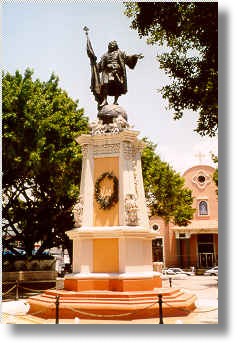
- Customs house
- Old Spanish social club (Casino)
- Eudaldo Báez García Boulevard
- Mayagüez Cultural Center – Includes the public library, a theater and the Tourism Office
- Our Lady of Candlemas Cathedral
- India Brewery
- Agricultural Experiment Station
- Mona Island and Monito Islet
- The Malecón (seaside promenade)
- Monument to Eugenio Maria de Hostos
- Casa Grande Historical Museum
- Eugenio María de Hostos Museum
- Mayagüez Recreation and Sports Complex
- Franco Bakery
- Puerto Rican Patriots Park
- Rosa M. Carrero Children’s Park of the Millennium
- Promenade
- Planetarium
- Columbus Square
- Yagüez Theater
- Mayagüez Campus of the University of Puerto Rico
- Dr. Juan A. Rivero Zoo
Distinguished Citizens:
- Federico Asenjo Arteaga – Journalist and writer of historical and costumbrista narratives.
- Alejandrina Benítez y de Arce de Gautier – Poet and mother of the poet José Gautier Benítez.
- Pedro Gerónimo Goyco – Physician, educator and political figure. Gerónimo Goyco worked for reform in the Antilles and the abolition of slavery in Puerto Rico while presiding the Partido Liberal Reformista (Liberal Reform Party).
- Eugenio María de Hostos – Known as “the citizen of the Americas,” a title bestowed on him in 1938 by the Organization of American States at its VIII conference.
- Simón Madera – Musician and composer. Madera played the violin, the clarinet and was a conductor and bandleader. He composed many pieces in many genres, including the famous danza Mis amores.
- Rafael Martínez Nadal – Public speaker, writer, and leader of the pro-statehood movement. Martínez was a founder of the Partido Unión Republicana (Republican Union Party), a senator (1921 – 1941) and president of the Puerto Rico Senate (1933 – 1941). He also wrote literary criticism, novels, and stories.
- José María Monge – Journalist and poet. Monge wrote in the costumbrista style.
- Salvador Perea – Historian, author of Historia de Puerto Rico: 1537-1700.
- Juan Ríus Rivera – General in the Cuban liberation army. He fought in Cuba in the 1868 and 1895 wars; a hero of the latter war, he was a delegate to the constitutional assembly of Cuba.
- Ernesto Ramos Antonini – Legislator and leader of the Popular Democratic Party. Ramos was a member of the Puerto Rico House of Representatives (1933 and 1941 – 1963) and president of the House (1945 – 1963). Ramos contributed to the economic development initiative known as Operation Bootstrap and the founding of the Free School of Music and the Conservatory of Puerto Rico.
- Josefina Rivera de Alvarez – Educator, essayist, and author of the Diccionario de la literatura puertorriqueña.
- Roberto Sánchez Vilella – Secretary of the Constitutional Assembly (1951 – 1952) and Governor of Puerto Rico from 1965 to 1969.
- Salvador Tió – Journalist, essayist and member of the Academia Puertorriqueña de la Lengua Española.
Public Schools sorted by educational levels.
Mayagüez Region
Mayagüez District
| Name | Level | Telephone | Address |
| Elementary | |||
| CASTILLO | K-6 | (787) 265-8344 | PO Box 3050, P.R. 00681-0000 |
| CENTRO ESTIMULACIÓN TEMPRANA | EE | (787) 832-1505 | Carr. # 2, P.R. 00680-0000 |
| CHARLES T. IRIZARRY | K-6 | (787) 832-4456 | PO Box 3050, P.R. 00681-0000 |
| CONCORDIA | K-3 | (787) 832-2081 | Bo. El Seco, P.R. 00680-0000 |
| CONSUELO PÉREZ CINTRÓN | K-6 | (787) 832-2055 | PO Box 6757, P.R. 00681-6757 |
| CRUCES | K-6 | (787) 833-2985 | PO Box 3050, P.R. 00681-0000 |
| CUESTA DE PIEDRAS | K-6 | (787) 832-9018 | PO Box 8010, P.R. 00680-0000 |
| DAVID G. FARRAGUT | K-6 | (787) 832-3344 | PO Box 2201, P.R. 00681-0000 |
| FEDERICO ASENJO | 3-6 | (787) 832-1305 | PO Box 7997 Suite 84, P.R. 00681-0000 |
| FRANCISCO BACO SORIA | K-6 | (787) 832-2314 | PO Box 4478, P.R. 00681-0000 |
| FRANCISCO VICENTY | K-2 | (787) 832-2310 | PO Box 797 Suite 125, P.R. 00681-0000 |
| FRANKLIN D. ROOSEVELT | K-6 | (787) 832-0482 | 182 Calle, P.R. P.R. 00680-0000 |
| LUIS MUÑOZ RIVERA | K-6 | (787) 834-7700 | PO Box 3050, P.R. 00681-0000 |
| MALEZAS | K-6 | (787) 833-8283 | PO Box 3050, P.R. 00681-0000 |
| MANUEL FERNÁNDEZ JUNCOS | K-6 | (787) 832-2233 | PO Box 155, P.R. 00680-0000 |
| MARIA LUISA ARCELAY | K-6 | (787) 833-8845 | PO Box 1647, P.R. 00681-1647 |
| MARIANO RIERA PALMER | K-6 | (787) 832-5262 | 257 Oeste, P.R. 00680-0000 |
| MIRADERO II | K-5 | (787) 832-0492 | Carr. 108 #1584, P.R. 00680-7504 |
| RAFAEL MARTÍNEZ NADAL | K-6 | (787) 832-2002 | PO Box 4427, P.R. 00680-0000 |
| RAMÓN VALLE SEDA | PK-6 | (787) 832-5105 | PO Box 812, P.R. 00681-0000 |
| RÍO CAÑAS ARRIBA | K-6 | (787) 832-4620 | PO Box 3050, P.R. 00680-0000 |
| SABANETAS MANÍ | K-5 | (787) 832-5080 | Calle Aduna 257 Suite 344, P.R. 00680-0000 |
| SEGUNDO RUIZ BELVIS | PK-6 | (787) 832-5078 | PO Box 3205, P.R. 00681-0000 |
| THEODORE ROSEVELT | K-6 | (787) 832-2204 | 153 Calle Pablo Casals, P.R. 00681-0000 |
| Intermediate | |||
| ELPIDIO H. RIVERA | 7-9 | (787) 833-5560 | PO Box 3050, P.R. 00681-3050 |
| JOSÉ GAUTIER BENÍTEZ | 7-9 | (787) 834-0900 | PMB 772 PO Box 7997 Suite 72, P.R. 00681-0000 |
| MANUEL A. BARRETO | 7-9 | (787) 832-3046 | PO Box 1260, P.R. 00681-1260 |
| MARIA DOLORES FARIA | 7-9 | (787) 834-9289 | Calle Candelaria, P.R. 00680-0000 |
| Secondary | |||
| ERNESTO RAMOS ANTONINI (MÚSICA) | 3-12 | (787) 834-3177 | PO Box 1048, P.R. 00681-1048 |
| ESTEBAN ROSADO BÁEZ | 7-9 | (787) 831-6199 | Suite 294, P.R. 00681-0000 |
| LA SOLEDAD | 6-9 | (787) 834-8944 | 153 Parcelas Soledad, P.R. 00680-0000 |
| RÍO CAÑAS ABAJO | K-9 | (787) 831-0050 | PO Box 3050, P.R. 00681-0000 |
| SU FELISA RINCÓN DE GAUTHIER | K-9 | (787) 831-5066 | PMB 356, P.R. 00681 |
| High School | |||
| CROEM | 9-12 | (787) 837-3720 | PO Box 1550, P.R. 00681-1550 |
| DR. PEDRO PEREA FAJARDO | 10-12 | (787) 833-0865 | PO Box 1330, P.R. 00681-1330 |
| EUGENIO MARIA DE HOSTOS | 10-12 | (787) 834-0600 | PO Box 130, P.R. 00681-0130 |
| SUPERIOR JOSÉ DE DIEGO | 10-12 | (787) 833-4804 | Apartado 8124 Marina Station, P.R. 00681-0000 |
Hymn:
By Luciano Quiñones
Mi patria es un oasis,
un jardín de gran belleza,
donde artistas y poetas
se llenan de inspiración;
y tiene en el Oeste,
una fulgurante estrella,
un pedacito de cielo,
parte del reino de Dios.
Hoy quiero regalarle
a esta ciudad de hermosura,
La Sultana del Oeste,
la del sabor a mangó;
mi más lírica alabanza,
mi poesía más fina y pura,
y una melodía bordada
con hilos del corazón.
¡Mayagüez! ¡Mayagüez!
Ciudad de las aguas puras,
valles y montes de ensoñación,
baja cantando tu río
a tu apacible bahía
donde al fin de cada día
se acuesta a dormir el Sol.
¡Mayagüez! ¡Mi Mayagüez!
Que orgullo para nosotros
tu historia es,
desde el humilde Taíno
que bautizó al Río Yagüez,
a Eugenio María de Hostos
que inmenso fue.
Eres cuna de cultura,
crisol de sabiduría,
la Virgen de la Candelaria
dotó a tus damas
de gran belleza y de simpatía.
Eres el lugar perfecto,
del Paraíso el Edén;
de orgullo se hinche mi pecho
para decirte: ¡Dios te bendiga,
mi Mayagüez! ¡Mayagüez!

